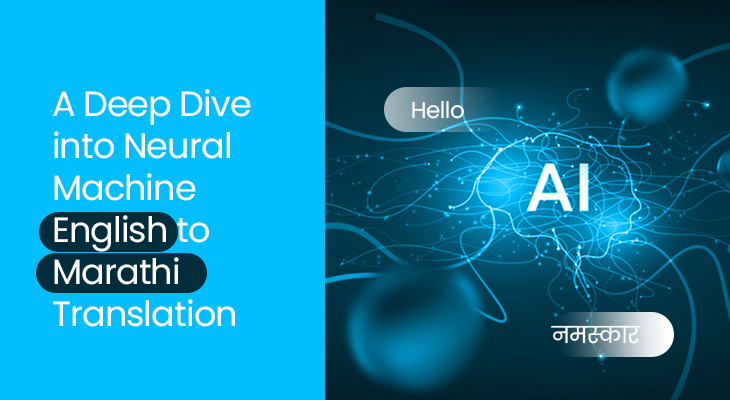Language has always been more than just a tool. It changes how we think, holds memories, and connects people who might not otherwise meet. When someone speaks English in a business meeting in Mumbai, or when a Marathi novel gets adapted for a global audience, there’s an invisible thread that ties cultures together. Translation has always been the bridge for that thread.
The bridge is critical for English to Marathi Translation. Around the world, English is the language of the internet, business, and schools. Marathi is not only a language spoken in one area; it is a living cultural identity for millions of people. Together, they highlight why modern translation technology has become urgent. And Neural Machine Translation (NMT) is the tool that seems to understand this urgency, finally.
Marathi Deserves Its Space
Think about Marathi for a moment. It’s the language of great poets like Kusumagraj and writers like P. L. Deshpande. It’s also the everyday tongue of farmers, shopkeepers, teachers, and students. It is spoken in parliament speeches, but also in street-side chats over chai. That range is rare.
With over 80 million speakers, Marathi is not some “minor” language that can be ignored in the digital rush. Yet for years, most online content skipped it. Websites had English and maybe Hindi, but Marathi often sat outside the door, waiting. Neural translation is one way to bring it inside the room.
The Old Ways of Translation Fell Short
Earlier, machines tried their best, but it was always obvious something was off. Rule-based systems worked like strict grammar teachers: word in, word out, no flexibility. If you fed them “He kicked the bucket,” they might spit out “त्याने बादलीला लाथ मारली,” which makes sense only if you picture someone abusing a bucket. The idiom about death gets lost.
Statistical models improved things a little. They relied on probabilities to predict what word was most likely to come next. But because they still broke sentences into pieces, the flow was awkward. The translations lacked rhythm and missed cultural undertones. Marathi, with its layered politeness levels and poetic rhythm, often ended up flattened.
Neural Networks Change the Game
Neural networks were a breath of fresh air. NMT didn’t only look at portions, it looked at complete sentences and even whole paragraphs. The meaning was just as important as the words. The model began to grasp how real people communicate with each other, rather than just the dictionary definitions of words.
This transition was a significant shift from English to Marathi Translation. The structure, tone, and nuance of the languages are different. But neural systems could handle them better than anything else. Suddenly, “The boy is playing in the garden” didn’t sound like robotic word order anymore. It came out as “मुलगा बागेत खेळत आहे.”
The Difficulties Hidden in Marathi
Marathi isn’t easy for machines. Let’s be fair, it isn’t even easy for humans sometimes. Sentence structures don’t match English. Marathi’s Subject-Object-Verb order confuses direct word mapping.
Then there’s morphology. Words bend depending on gender, tense, and context. A single English word might have four Marathi versions depending on who’s speaking and to whom. Add idioms, “hit the sack,” “spill the beans”, and the machine might just throw up its hands.
Tone is another slippery slope. Marathi has clear differences between speaking casually to a friend, politely to a stranger, and formally to an elder. English doesn’t always mark this distinction. A machine translating “you” might miss whether it’s “तू,” “तुम्ही,” or even “आपण.” Small mistake, big impact.
How Neural Translation Works?
Behind the scenes, NMT doesn’t “think” like us, but the process has its charm. The encoder reads the input sentence. The decoder writes the output. In between, attention mechanisms keep focusing on which word matters most at each step.
Imagine a teacher helping a student read a line, pointing at each part as they go. That’s attention. It ensures the meaning doesn’t drift away halfway through the sentence.
That’s why when translating “The committee reviewed the report before the meeting,” the system knows not to confuse the order of events. It keeps “before the meeting” attached to the correct part. For Marathi, where word order is flexible, this is gold.
Where do People See It Already?
If you think this is all theory, just look around. Shopping platforms quietly use English to Marathi Translation so customers can read descriptions in their mother tongue. Kids learning through ed-tech apps get explanations in both languages. Farmers check weather updates that are instantly converted. Entertainment platforms provide Marathi subtitles to ensure global audiences don’t miss a beat.
It’s already woven into daily life, sometimes invisibly. People may not even realize they are using neural translation; it just happens in the background.
The Stumbling Blocks Still There
Of course, it’s not perfect. Machines still get confused when the same word has multiple meanings. They still stumble over long, complex sentences. Data is another problem. English has oceans of digital text; Marathi, far less. The machine struggles to learn when it lacks sufficient instances.
The hardest gap to fill is cultural depth. A Marathi reader might find a proverb funny, but it may not translate well when taken too literally. Machines aren’t smart enough yet to catch those little sparks.
That’s why many businesses strike a balance between mechanical speed and human touch. Allow the system to do the hard work, and then let people with expertise make it better. It saves time without losing cultural accuracy.
What will happen in the future?
This is when things become interesting. Transfer learning, which lets models trained on English or French work with Marathi, is making things possible. They are developing specialized models for law, medicine, and banking to ensure translations sound more specific.
Users may be able to fix translations right away with interactive systems, which teach the machine as they go. Voice and speech are another frontier. Imagine a Marathi speaker giving a command in their tongue, and an English interface responding instantly, or the reverse. That’s not science fiction anymore.
In a few years, the gap between English to Marathi Translation might feel less like a wall and more like a doorway.
Stepping Back
Step back for a moment. Translation has never been about machines alone. It’s about humans using those machines. A farmer checking seed prices, a student applying for scholarships, a traveler reading signboards, and a shopkeeper expanding to an online marketplace all depend on language.
For businesses, this isn’t just an add-on feature. It’s a trust-builder. Speak the customer’s language, and they listen. Speak only in English, and you risk sounding distant.
Many people overlook the fact that translation encompasses more than just words. It’s about respect, trust, and the calm pride that comes from being understood. When Marathi gets the space it deserves online, it shows every speaker that their voice is just as important as any other language in the world.
Closing Thought
Neural models don’t always get the English to Marathi Translation. It still trips and misses the point. But the growth is real. We used to receive outputs that were stiff and based on rules, but now they sound almost like people.
And in the big picture, it’s more than just technology. It’s about putting Marathi in the right place in the future of technology. Every little translation helps people, stories, businesses, and communities connect. Every sentence makes the bridge stronger.



